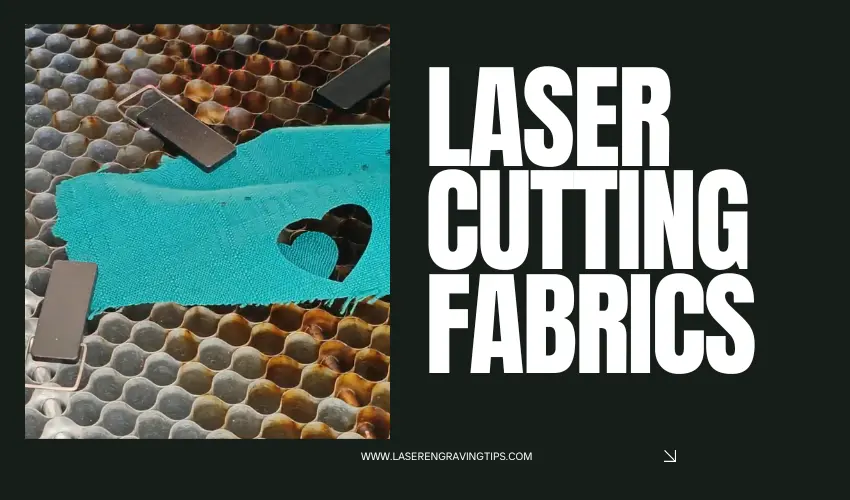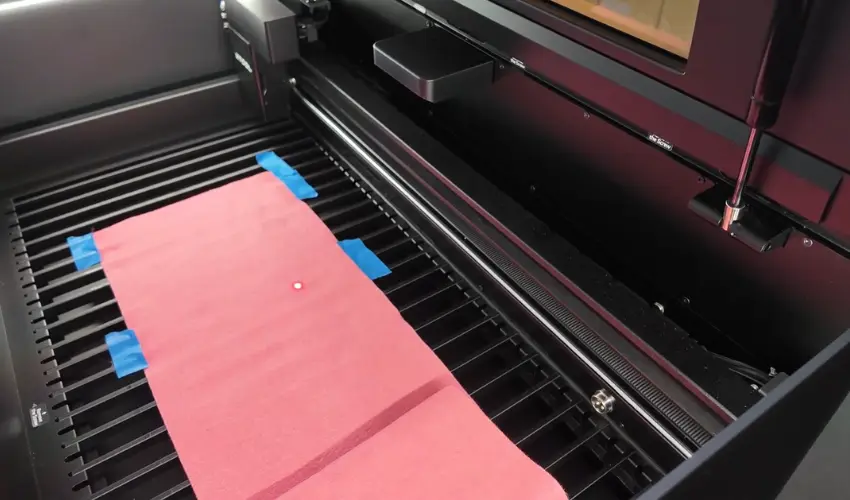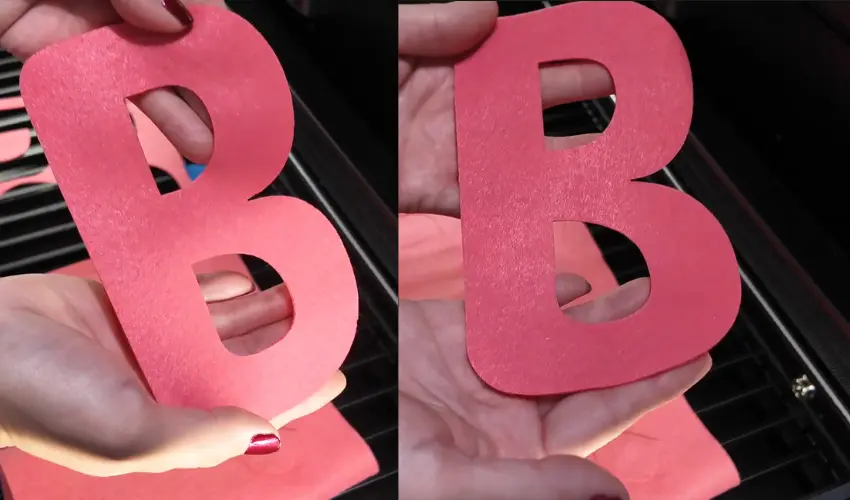Laser cutting fabrics has become a game-changer in the textile and fashion industry. Whether you’re a hobbyist, small business owner, or professional designer, laser technology allows you to cut and engrave fabrics with unmatched precision, speed, and design flexibility.
Why use a laser cutter for fabrics? Laser cutting fabrics provides precise, intricate designs, sealed edges that resist fraying, and less material waste compared to traditional cutting methods.
Table of Contents
In this guide, you’ll learn everything you need to know about laser cutting fabrics, including the best machines to use, suitable materials, preparation tips, and common troubleshooting solutions.
What Is Laser Cutting Fabrics?
Laser cutting fabric is the process of using a highly focused laser beam to cut or engrave textiles. Unlike traditional scissors, rotary cutters, or die-cutting machines, lasers provide cleaner edges, reduce fraying, and make it possible to create complex and intricate designs with minimal effort.
The process works by focusing light energy onto the fabric, which either vaporizes or melts the fibers along the cutting path. This leaves behind a precise, sealed edge—especially on synthetic fabrics.
Benefits of Laser Cutting Fabrics

Why choose laser cutting over traditional methods?
- Unparalleled Precision – Create detailed shapes and patterns without jagged edges.
- Speed & Efficiency – Cut multiple pieces quickly, perfect for batch production.
- Less Waste – Optimize designs and reduce fabric scraps.
- Sealed Edges – Synthetic fabrics like polyester or nylon won’t fray.
- Design Versatility – Works for fashion, quilting, upholstery, embroidery, and custom crafts.
What Fabrics Can You Laser Cut?
Not all fabrics behave the same way under a laser, but many are excellent candidates.
Fabric Type | Characteristics | Laser Cutting Performance |
|---|---|---|
Cotton | Natural, breathable | Cuts well, may fray slightly |
Linen | Durable, natural | Precise cuts, minimal fraying |
Polyester | Synthetic | Edges melt to prevent fraying |
Nylon | Strong synthetic | Clean, sealed cuts |
Felt | Thick, non-woven | Smooth, fray-free edges |
Silk | Thin, delicate | Requires low power, very precise |
Pro tip: Always test your fabric scraps first, as weave, thickness, and coatings can affect results
Best Laser Cutters for Fabric
Not all lasers are equally effective on fabric. Here’s what you need to know:
CO₂ Lasers
- Best for cutting fabric.
- Their 10,600 nm wavelength is highly absorbed by textiles.
- Clean cuts with minimal burn marks.
Diode Lasers
- More affordable for hobbyists.
- Great for darker fabrics, denim, felt, fleece, and quilting cotton.
- Struggle with white, transparent, or reflective fabrics.
When choosing a laser cutter for fabric, look for:
- CO₂ Laser Cutters – The most popular and versatile choice for textiles.
- Power Levels – 40–60W is ideal for most fabrics; higher wattage for thicker materials.
- Adjustable Speed Settings – Helps prevent scorching delicate fabrics.
- Safety Features – Protective enclosures, air assist, and ventilation are must-haves.
- Ease of Use – Software compatibility and intuitive controls make a big difference.
Best CO₂ Laser Cutter For Fabrics: xTool P2S 55W CO₂ Laser

The xTool P2S 55W Desktop CO2 Laser Cutter is one of the most powerful and versatile fabric-cutting machines available today. With its high-powered 55W CO₂ laser tube, it delivers clean, precise, and fray-free cuts on a wide range of textiles, including cotton, linen, polyester, silk, nylon, and felt.
What makes the P2S stand out is its large working area and advanced air-assist system, ensuring smooth edges without scorch marks. The cutter also supports smart safety features, intuitive software, and fast cutting speeds, making it ideal for both beginners and professionals.
If you’re serious about fabric cutting, embroidery appliqués, quilting, or fashion design, the xTool P2S 55W offers the perfect balance of power, precision, and ease of use.
Verdict: The xTool P2S 55W is hands down the best CO₂ laser cutter for fabrics, combining speed, accuracy, and professional-grade results.
Best Diode Laser Cutter For Fabrics: xTool S1 40W

The xTool S1 40W Diode Laser is a top choice for anyone looking to cut and engrave fabrics with speed and precision. With its powerful 40W laser module, it slices through cotton, polyester, felt, denim, and linen with ease, producing clean edges and minimal fraying. Its fully enclosed design, advanced air assist, and auto-focus system make it safer and more efficient than most open-frame diode lasers.
Thanks to its LightBurn compatibility and user-friendly xTool Creative Space software, the S1 is perfect for both beginners and professionals. It also supports accessories like the RA2 Pro rotary attachment for cylindrical projects.
Verdict: The xTool S1 40W is one of the best diode laser cutters for fabrics, offering unmatched safety, power, and versatility in a compact design.
Here’s a comparison table for the best laser cutters for fabrics: the xTool P2S CO2 Laser and the xTool S1 40W Diode Laser.
Feature | xTool P2S 55W CO2 Laser | xTool S1 40W Diode Laser |
|---|---|---|
Laser Type | CO2 (55W) | Diode (40W) |
Best For | Large-scale fabric cutting, quilting, upholstery, professional textile work | Hobbyists, small businesses, detailed fabric cutting |
Supported Fabrics | Cotton, linen, silk, polyester, felt, denim, leather, organza, delicate synthetics | Cotton, linen, polyester, felt, denim, fleece, quilting fabric |
Cutting Speed | Faster due to high wattage & CO2 efficiency | Slightly slower than CO2 but still strong for thick fabrics |
Edge Quality | Very clean, often heat-sealed on synthetic fabrics | Clean cuts; some light charring on delicate fabrics |
Work Area | Large bed for bulk fabric projects | Compact but enclosed for safe desktop use |
Software Compatibility | xTool Creative Space, LightBurn | xTool Creative Space, LightBurn |
Accessories | Automatic conveyor feeder, rotary attachment (RA2 Pro), air assist | RA2 Pro rotary, risers, air assist |
Ease of Use | Professional-grade, larger learning curve | Beginner-friendly, intuitive software |
Portability | Larger desktop unit, less portable | More compact, easier to fit in small workspaces |
Price Range | Higher ($3,800+) | Mid-range ($2,000 – $3,500) |
Overall Verdict | Best for professionals who need speed, precision, and large-scale textile cutting | Best for hobbyists and small businesses needing versatility and affordability |
How to Prepare Fabric for Laser Cutting
Preparation makes all the difference in achieving clean results:
- Clean and Press – Remove dirt, coatings, or wrinkles for smoother cuts.
- Secure Fabric – Use weights, magnets, or a vacuum bed to keep it from shifting.
- Check Settings – Adjust laser speed and power according to the fabric type.
- Test First – Cut a small scrap before committing to your full project.
How to Laser Cut Felt with The xTool P2S (Step-by-Step Tutorial)
If you’ve ever tried cutting felt by hand or with a craft machine like the Cricut, you know it can be tedious. The edges fray, the cuts aren’t always precise, and detailed shapes are almost impossible. That’s where a laser cutter like the xTool P2S comes in.
In this step-by-step tutorial, I’ll show you exactly how to cut felt with the xTool P2S — from preparing your design to dialing in the right settings for clean, professional-looking cuts.
Why Use the xTool P2S for Cutting Felt?
The xTool P2S CO₂ laser cutter is powerful enough to cut fabric and felt quickly, while leaving smooth edges with no fraying or melting. Compared to craft cutters, it allows for:
- Larger designs (not limited by mat size).
- Faster cutting speeds.
- Cleaner, sharper results for intricate details.
Materials You’ll Need
- xTool P2S laser cutter
- Sheets of felt (any color, 1–3mm thick works best). We recommend these 1/25″ 10-Color Felt Fabric Squares from xTool
- Painter’s tape (to secure felt to the bed)
- xTool Creative Space software (free design program)
- Optional: embroidery floss, needle, and stuffing (if making banners or stuffed shapes)
Step 1: Prepare Your Design in xTool Creative Space
- Open xTool Creative Space (free to download).
- Create your design.
- Adjust the size.
- Set the layer to “Cut”.
Step 2: Secure Your Felt to the Laser Bed

- Place your felt sheet on the P2S’s bed.
- Use painter’s tape on the edges to prevent shifting during cutting.
- Close the lid and refresh the bed image in the software so you can align your design.
Step 3: Adjust Your Cutting Settings
Felt isn’t a preset material in xTool Creative Space, so you’ll need to enter your own settings.
- Recommended starting settings:
- Power: 20%
- Speed: 16mm/s
- Passes: 1
Always do a small test cut (like a circle or square) before committing to the full project
Step 4: Run a Test Cut
- Insert a small shape (like a 0.5” circle).
- Run the cut and check the edges.
- If the felt doesn’t cut all the way through → lower the speed slightly or increase power.
- If edges look melted → increase the speed or lower power.
This balance between power and speed is the key to clean felt cuts.
Step 5: Cut Your Design
Once your test cut looks clean:
- Position your design on the felt sheet.
- Double-check your settings.
- Click Process → Start.
- Let the xTool P2S do the cutting — it should only take a few minutes, even for multiple shapes.
Step 6: Remove and Finish
- Gently remove your felt pieces. They should pop out cleanly with no frayed or melted edges.
- If making a banner or stuffed shapes, stitch two layers together with embroidery floss and fill with poly stuffing.
Final Results

The xTool P2S laser cutter delivers perfect cuts on felt — smooth edges that look like they were cut with scissors, but far more precise. Whether you’re making banners, appliqués, or fabric crafts, it’s one of the best tools for cutting felt quickly and cleanly.
Pro Tip: Once you’ve found felt settings that work on your machine, save them in your software so you can reuse them for future projects without retesting
xTool P2S Fabric Cutting Settings (Quick Reference Chart)
Fabric Type | Power (%) | Speed (mm/s) | Passes | Notes |
|---|---|---|---|---|
Cotton (Lightweight) | 18–22% | 20–25 | 1 | Cuts cleanly, may fray slightly. Use painter’s tape to secure. |
Linen | 20–24% | 18–22 | 1 | Similar to cotton but slightly denser. Test before cutting. |
Polyester | 15–20% | 22–28 | 1 | Melts edges slightly, prevents fraying. Great for appliqué. |
Felt (1–3mm) | 18–22% | 14–18 | 1 | Thick fabric, cut slower for precision. |
Silk | 12–16% | 25–30 | 1 | Very delicate — keep power low to avoid burning. |
Nylon | 15–18% | 20–25 | 1 | Melts edges; adjust carefully to avoid hard edges. |
Denim | 25–30% | 12–16 | 1–2 | Heavy fabric; may need 2 passes for thick denim. |
xTool S1 40W Fabric Cutting Settings (Quick Reference Chart)
Fabric Type | Power (%) | Speed (mm/s) | Passes | Air Assist | Notes |
|---|---|---|---|---|---|
Quilting Cotton | 85–90% | 230–250 | 1 | ON (max) | Wash & press flat; tape down edges |
Felt (wool blend) | 90–95% | 180–200 | 1–2 | ON | Cuts clean, edges may seal slightly |
Fleece | 85–90% | 200–220 | 1–2 | ON | Great for applique, less fraying |
Denim | 90–95% | 150–180 | 2 | ON | Test for thickness; edges may darken |
Polyester | 85–90% | 220–240 | 1 | ON | Avoid coated polyester (may melt) |
Linen | 85–90% | 230–250 | 1 | ON | Wash first to remove chemicals |
T-Shirt Knit | 85–90% | 220–240 | 1 | ON | Stretch fabrics may need extra securing |
Best Practices for Laser Cutting Fabrics
- Use lower power and higher speed settings for delicate fabrics like silk.
- Increase power and slow speed slightly for thicker materials like felt.
- Enable air assist to prevent scorching.
- Always keep your machine clean and calibrated for consistent performance.
Common Issues & Troubleshooting
- Fraying Edges → Increase power slightly or reduce cutting speed.
- Burn Marks → Lower laser power, increase speed, or add masking tape on fabric.
- Fabric Shifting → Use stronger clamps or a tack spray.
- Uneven Cuts → Re-check focus height and fabric placement.
Safety Tips for Laser Cutting Fabric
- Always work in a well-ventilated area to avoid fumes.
- Use safety goggles when operating open-laser machines.
- Avoid cutting fabrics coated with PVC or harmful chemicals.
- Keep a fire extinguisher nearby for extra precaution.
Frequently Asked Questions
Can all fabrics be cut with a laser cutter?
Not all fabrics are safe or suitable for laser cutting. Natural fabrics like cotton, denim, silk, and wool work well, as do many synthetics such as polyester and nylon. However, PVC- or vinyl-based fabrics should never be cut because they release toxic chlorine gas when burned. Always confirm the material’s composition before cutting.
What type of laser is best for cutting fabrics?
A CO₂ laser is generally the best option because its wavelength is well-absorbed by fabric fibers, allowing for smooth, precise cuts with sealed edges. Diode lasers can also cut fabrics but may struggle with lighter or reflective materials, such as white cotton or transparent fabrics.
Does laser cutting fabrics prevent fraying?
Yes, in many cases. The heat from the laser slightly melts or seals the fabric’s edges, which helps prevent fraying, especially in synthetic fabrics like polyester or nylon. Natural fabrics like cotton may still fray slightly, but far less than with scissors or rotary blades.
Final Thoughts
Laser cutting fabrics is one of the most efficient and creative ways to bring your textile projects to life. With the right machine, settings, and preparation, you’ll enjoy precise cuts, sealed edges, and endless design possibilities.
Whether you’re making custom clothing, home décor, or intricate embroidery appliqués, mastering laser cutting fabrics will elevate your projects to a professional level.
